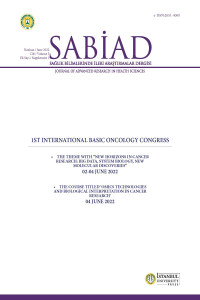Abstract
Osteosarcoma (OSA) is an aggressive bone tumor that occurs primarily in children and adolescents worldwide, with a high metastatic and recurrence
ability. OSA is characterized by the transformation of mesenchymal cells and the formation of osteoid tissue. Although recent advancements have
improved the current therapeutic management of OSA, the clinical outcomes of the disease still remain unsatisfactory. Therefore, it is important to
determine the novel diagnostic markers and/or therapeutic targets for OSA. Autophagy is a highly conserved self-degradative process that plays a crucial
role in various physiological mechanisms such as survival, homeostasis, development and differentiation. Dysfunction of autophagy is the relationship with
the onset and development of several types of cancer, including OSA. Long non-coding ribonucleic acids (lncRNAs), a group of non-coding RNAs, regulate
various pathophysiological mechanisms such as inflammation, autophagy and apoptosis. Recent studies investigating the role of lncRNAs in the
pathogenesis of OSA have shown that these molecules might have diagnostic and therapeutic importance for the prevention of OSA. Here, we focus on
lncRNAs that modulate autophagy in OSA and discuss the potential clinical values of lncRNAs for OSA. The current study contributes to a better
understanding of OSA pathogenesis and to the development of novel therapeutic approaches for the prevention of OSA.
Keywords
References
- Wellek S, Blettner M. On the proper use of the crossover design in clinical trials: part 18 of a series on evaluation of scientific publications. Dtsch Arztebl Int. 2012;109(15):276-81.
Abstract
Osteosarcoma (OSA) is an aggressive bone tumor that occurs primarily in children and adolescents worldwide, with a high metastatic and recurrence ability. OSA is characterized by the transformation of mesenchymal cells and the formation of osteoid tissue. Although recent advancements have improved the current therapeutic management of OSA, the clinical outcomes of the disease still remain unsatisfactory. Therefore, it is important to determine the novel diagnostic markers and/or therapeutic targets for OSA. Autophagy is a highly conserved self-degradative process that plays a crucial role in various physiological mechanisms such as survival, homeostasis, development and differentiation. Dysfunction of autophagy is the relationship with the onset and development of several types of cancer, including OSA. Long non-coding ribonucleic acids (lncRNAs), a group of non-coding RNAs, regulate various pathophysiological mechanisms such as inflammation, autophagy and apoptosis. Recent studies investigating the role of lncRNAs in the pathogenesis of OSA have shown that these molecules might have diagnostic and therapeutic importance for the prevention of OSA. Here, we focus on lncRNAs that modulate autophagy in OSA and discuss the potential clinical values of lncRNAs for OSA. The current study contributes to a better understanding of OSA pathogenesis and to the development of novel therapeutic approaches for the prevention of OSA.
Keywords
References
- Wellek S, Blettner M. On the proper use of the crossover design in clinical trials: part 18 of a series on evaluation of scientific publications. Dtsch Arztebl Int. 2012;109(15):276-81.
Details
| Primary Language | English |
|---|---|
| Subjects | Clinical Sciences |
| Journal Section | Meeting Abstract |
| Authors | |
| Publication Date | August 9, 2022 |
| Submission Date | June 23, 2022 |
| Published in Issue | Year 2022 Volume: 5 Issue: S-1 |


